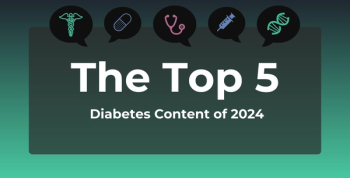
Diabetes
Latest News
Latest Videos

Podcasts
CME Content
More News

The approval marks the second for a generic in this class of medications indicated to improve glycemic control in patients with type 2 diabetes as a complement to diet and exercise.

The FDA issued a complete response letter for sotagliflozin (Zynquista) as an adjunct to insulin therapy for glycemic control.

Ian Neeland, MD, discusses the CINEMA program's impact on addressing social determinants of health (SDOH) in Ohio and the importance of precision risk tests to reduce cardiovascular metabolic disease risk.

Ellen Francis, PhD, discusses the benefits, challenges, and future implications of implementing earlier diabetes screening for pregnant women.

Patients with type 2 diabetes who use semaglutide have more than double the risk of severe optic nerve damage than those who don’t use the drug.

This year’s top diabetes content focused on pediatric metabolic health, misconceptions about weight loss drugs, and more.

Reducing systolic blood pressure to less than 120 mmHg lowered the risk of major cardiovascular events for most people with type 2 diabetes in the Blood Pressure Control Target in Diabetes trial.

Young adults with type 2 diabetes and lower incomes face significantly higher mortality risks, highlighting socioeconomic disparities in health outcomes.

Employees living with diabetes often face unique challenges, such as managing blood sugar levels, balancing medication, and preventing complications, all while maintaining their professional responsibilities. This condition can lead to increased absenteeism, reduced productivity, and rising health care costs.

Sanjula Jain, PhD, chief research officer at Trilliant Health, discusses the rapid adoption of glucagon-like peptide 1 inhibitors for diabetes and preventive care for obesity and late-onset diabetes.

Unmet social needs in certain neighborhoods contribute to disparities in diabetes care, leading to greater reliance on emergency services, fewer preventive measures, and higher rates of complications.

Recent results from a new diabetes reversal program demonstrate the reliable, sustained benefits of nonpharmacological interventions in the management of diabetes and overall health of patients.

The 2024 Trends Shaping the Health Economy report gave a past, present, and future look at diabetes care in the US and the role of obesity in these trends.

The Senate HELP Committee held a hearing to address the high cost of semaglutide drugs, finding that many patients cannot afford them despite their potential benefits.

The Federal Trade Commission (FTC) has filed a legal complaint accusing the 3 largest pharmacy benefit managers (PBMs) in the US—Caremark, Express Scripts, and Optum Rx—of inflating insulin costs for patients, prompting renewed calls for PBM reform.

Jennifer Green, MD, of Duke University, stresses the need for high-risk patients with diabetes to use medications that prevent future cardiovascular and kidney events.

Jennifer Green, MD, of Duke University, explained that while CMS-negotiated drug prices under the Inflation Reduction Act (IRA) may not immediately lower patients' costs, they could improve access to expensive medications.

Ken Cohen, MD, of Optum Care, advocates for glucagon-like peptide 1 (GLP-1) tiering for patients with diabetes based on comorbidities, like body mass index (BMI) and cardiovascular disease (CVD).

This study characterized antihyperglycemic medication use after chronic kidney disease onset among patients with type 2 diabetes to uncover potential unmet needs in clinical practice.

Ian Neeland, MD, of University Hospitals and Case Western Reserve University, recommended a team-based, comprehensive approach to managing diabetes and its related complications.

New findings add to the relationship between red meat and processed meat consumption and the risk of type 2 diabetes.

The expanded approval for the Omnipod 5 system now allows automated insulin delivery (AID) for adults with type 2 diabetes, offering a new option for better glucose management without daily injections.

New findings add to the pile of research on the possible neuroprotective effects of drugs like dapagliflozin, empagliflozin, and dulaglutide for patients with type 2 diabetes.

Diabetic macular edema treatment options include anti-vascular endothelial growth factor (anti-VEGF) injections and laser therapy, with patient-specific factors guiding the best approach.

Despite guidelines recommending annual screenings, nearly half of patients with diabetes miss critical eye exams, explains Jose A. Martinez, MD, president and retina specialist at Austin Retina Associates.


















































